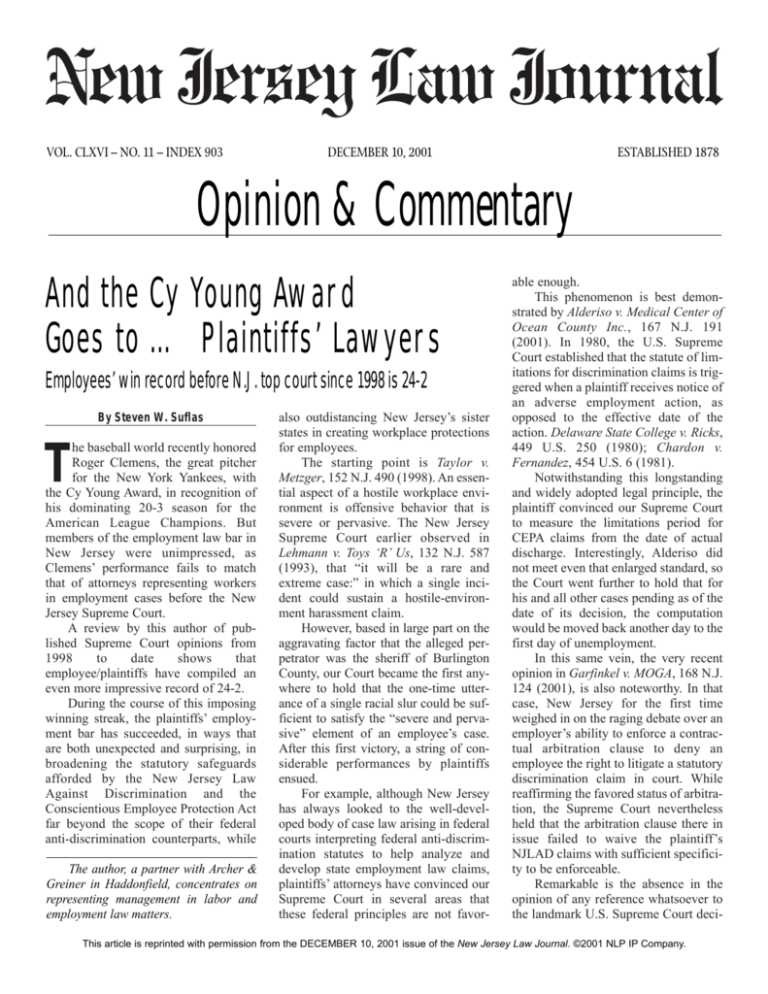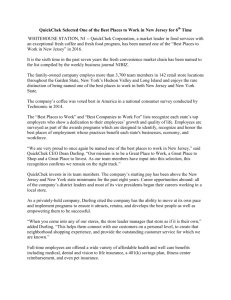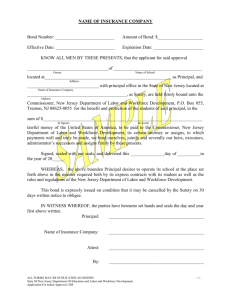to read the full post. - Archer & Greiner, P.C.
advertisement

VOL. CLXVI – NO. 11 – INDEX 903 DECEMBER 10, 2001 ESTABLISHED 1878 Opinion & Commentary And the Cy Young Award Goes to … Plaintiffs’ Lawyers Employees’ win record before N.J. top court since 1998 is 24-2 By Steven W. Suflas he baseball world recently honored Roger Clemens, the great pitcher for the New York Yankees, with the Cy Young Award, in recognition of his dominating 20-3 season for the American League Champions. But members of the employment law bar in New Jersey were unimpressed, as Clemens’ performance fails to match that of attorneys representing workers in employment cases before the New Jersey Supreme Court. A review by this author of published Supreme Court opinions from 1998 to date shows that employee/plaintiffs have compiled an even more impressive record of 24-2. During the course of this imposing winning streak, the plaintiffs’ employment bar has succeeded, in ways that are both unexpected and surprising, in broadening the statutory safeguards afforded by the New Jersey Law Against Discrimination and the Conscientious Employee Protection Act far beyond the scope of their federal anti-discrimination counterparts, while T The author, a partner with Archer & Greiner in Haddonfield, concentrates on representing management in labor and employment law matters. also outdistancing New Jersey’s sister states in creating workplace protections for employees. The starting point is Taylor v. Metzger, 152 N.J. 490 (1998). An essential aspect of a hostile workplace environment is offensive behavior that is severe or pervasive. The New Jersey Supreme Court earlier observed in Lehmann v. Toys ‘R’ Us, 132 N.J. 587 (1993), that “it will be a rare and extreme case:” in which a single incident could sustain a hostile-environment harassment claim. However, based in large part on the aggravating factor that the alleged perpetrator was the sheriff of Burlington County, our Court became the first anywhere to hold that the one-time utterance of a single racial slur could be sufficient to satisfy the “severe and pervasive” element of an employee’s case. After this first victory, a string of considerable performances by plaintiffs ensued. For example, although New Jersey has always looked to the well-developed body of case law arising in federal courts interpreting federal anti-discrimination statutes to help analyze and develop state employment law claims, plaintiffs’ attorneys have convinced our Supreme Court in several areas that these federal principles are not favor- able enough. This phenomenon is best demonstrated by Alderiso v. Medical Center of Ocean County Inc., 167 N.J. 191 (2001). In 1980, the U.S. Supreme Court established that the statute of limitations for discrimination claims is triggered when a plaintiff receives notice of an adverse employment action, as opposed to the effective date of the action. Delaware State College v. Ricks, 449 U.S. 250 (1980); Chardon v. Fernandez, 454 U.S. 6 (1981). Notwithstanding this longstanding and widely adopted legal principle, the plaintiff convinced our Supreme Court to measure the limitations period for CEPA claims from the date of actual discharge. Interestingly, Alderiso did not meet even that enlarged standard, so the Court went further to hold that for his and all other cases pending as of the date of its decision, the computation would be moved back another day to the first day of unemployment. In this same vein, the very recent opinion in Garfinkel v. MOGA, 168 N.J. 124 (2001), is also noteworthy. In that case, New Jersey for the first time weighed in on the raging debate over an employer’s ability to enforce a contractual arbitration clause to deny an employee the right to litigate a statutory discrimination claim in court. While reaffirming the favored status of arbitration, the Supreme Court nevertheless held that the arbitration clause there in issue failed to waive the plaintiff’s NJLAD claims with sufficient specificity to be enforceable. Remarkable is the absence in the opinion of any reference whatsoever to the landmark U.S. Supreme Court deci- This article is reprinted with permission from the DECEMBER 10, 2001 issue of the New Jersey Law Journal. ©2001 NLP IP Company. 2 NEW JERSEY LAW JOURNAL, DECEMBER 10, 2001 sion in Circuit City Stores v. Adams, 532 U.S. 105 (2001), issued just a few months earlier, holding that the Federal Arbitration Act pre-empts any state employment laws restricting or limiting agreements to arbitrate state statutory claims. Plaintiffs have also succeeded in significantly expanding the geographic reach of New Jersey’s anti-discrimination statutes. Thus, in Mehlman v. Mobil Oil Corp., 153 N.J. 163 (1998), the plaintiff successfully argued that CEPA protected his objections in New Jersey to his employer’s environmental practices in Japan. In Blakey v. Continental Airlines Inc., 164 N.J. 38 (2000), the NJLAD’s prohibitions against workplace harassment were extended to comments by co-workers made in postings on an Internet chat room maintained, not by the employer, but by a third party online provider. Furthermore, having concluded that the NJLAD rules cyberspace, the Supreme Court went on to hold that co-workers posting allegedly harassing comments were potentially subject to the jurisdiction of New Jersey state courts, even though they had never set foot in the state. Finally, in McDonnell v. State of Illinois, 163 N.J. 298 (2000), (per curiam), the pro se plaintiff was employed in New Jersey by the state of Illinois as a revenue auditor. Not only did New Jersey decline to extend comity to her sister state, but our Supreme Court affirmed an interpretation of the NJLAD that the statutory definition of employer which “includes the State” was intended to apply to all states. Plaintiffs have achieved other noteworthy victories, convincing the Court to significantly expand the categories of employee conduct protected by CEPA, Higgins v. Pascack Valley Hospital, 158 The plaintiffs’ employment bar has succeeded in broadening the statutory safeguards afforded by the N.J. Law Against Discrimination and the Conscientious Employee Protection Act far beyond the scope of their federal anti-discrimination counterparts. N.J. 404 (1999), as well as Roach v. TRW Inc, 164 N.J. 598 (2000), and DeLisa v. County of Bergen, 165 N.J. 140 (2000); to hold successor employers responsible for allegations of workplace discrimination by their predecessors, Baker v. National State Bank, 161 N.J. 220 (1999), and Wilson v. Wal- 166 N.J.L.J. 903 Mart Stores, 158 N.J. 263 (1999); to rule that statutory punitive damages are recoverable against public entities, Cavuoti v. New Jersey Transit Corp., 161 N.J. 107 (1999); and to apply the age discrimination protections of the NJLAD to employees of any age, not just to older workers, Bergen Commercial Bank v. Sisler, 157 N.J. 188 (1999). On the other hand, the two employer “victories” during this period are akin to 1-0 losses for plaintiffs. In one, the Court reached the unsurprising conclusion that a person who was statutorily disqualified from obtaining public employment as a result of a criminal conviction could not pursue wrongful discharge claims under NJLAD and CEPA. Cedeno v. Montclair State University, 163 N.J. 473 (2000). In the other, the Court held that the statutory status of an assistant prosecutor as an at-will employee superceded the terms of an employee manual. Golden v. County of Union, 163 N.J. 420 (2000). Significantly, since both of these prevailing defendants were public bodies, private sector employers have “worn the collar” during the past four years. With the effective advocacy of the plaintiffs’ employment bar, the New Jersey Supreme Court has enlarged state law protections for New Jersey employees to an extent unparalleled anywhere else in the nation. Baseball fans can always say: “Wait ’til next year.” It remains to be seen how long management advocates will have to wait for a victory. ■






